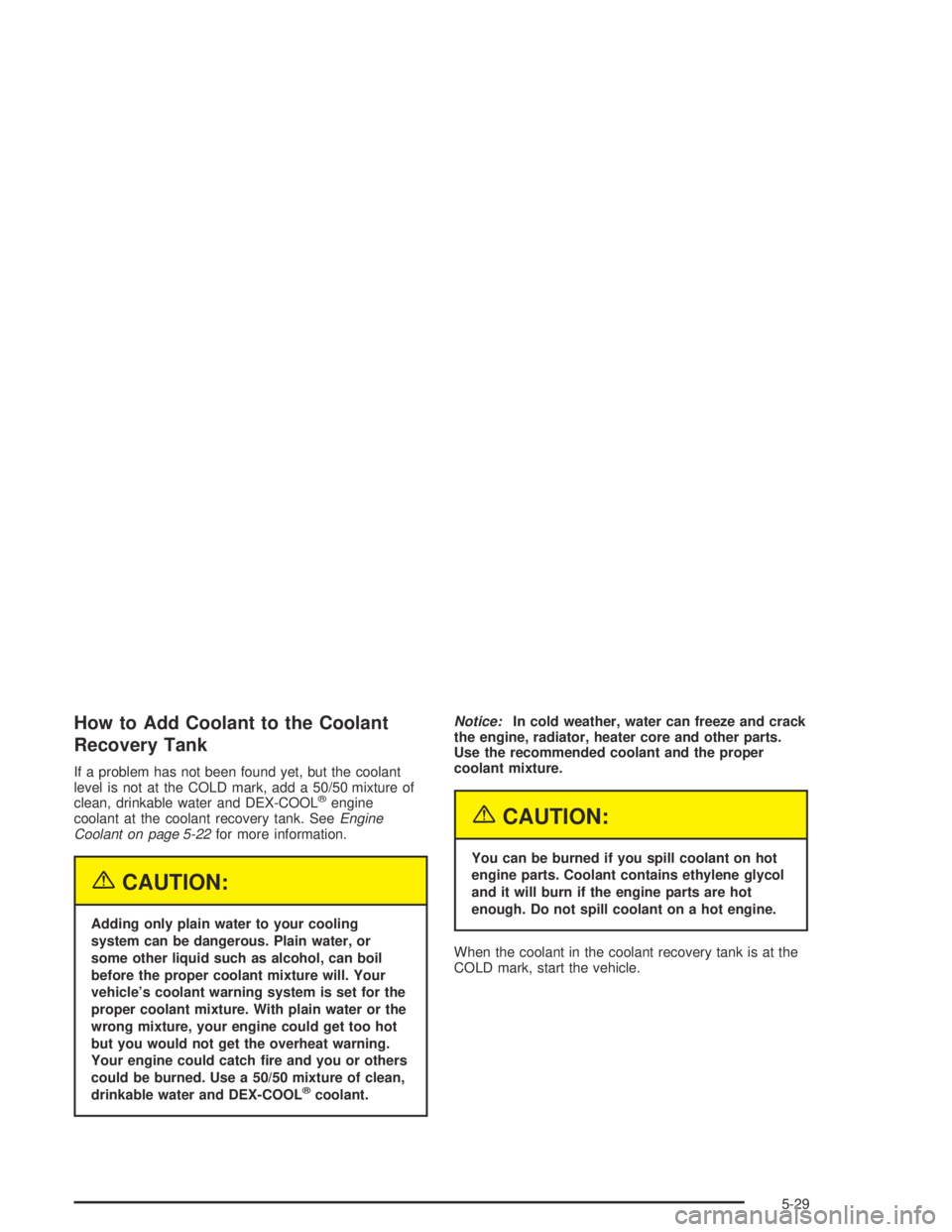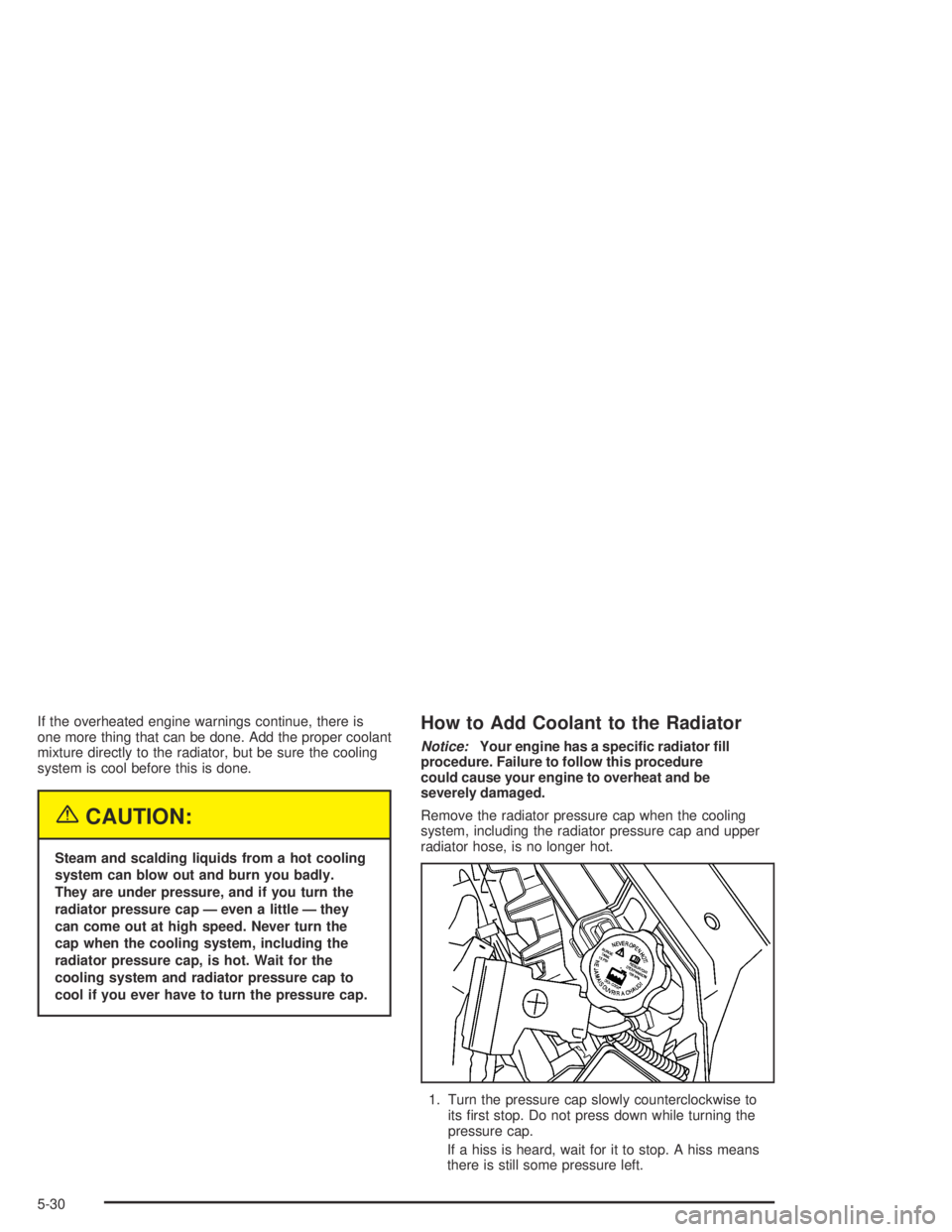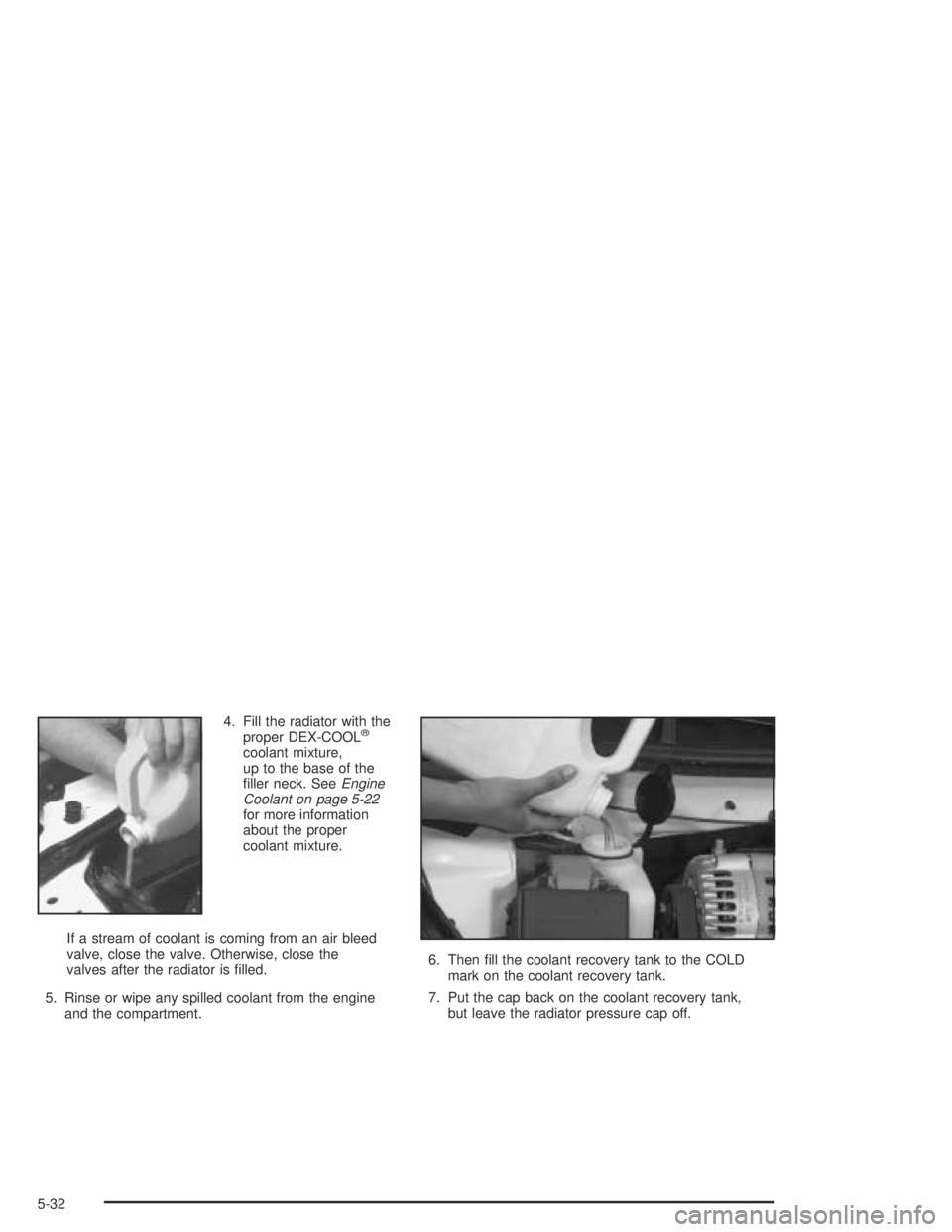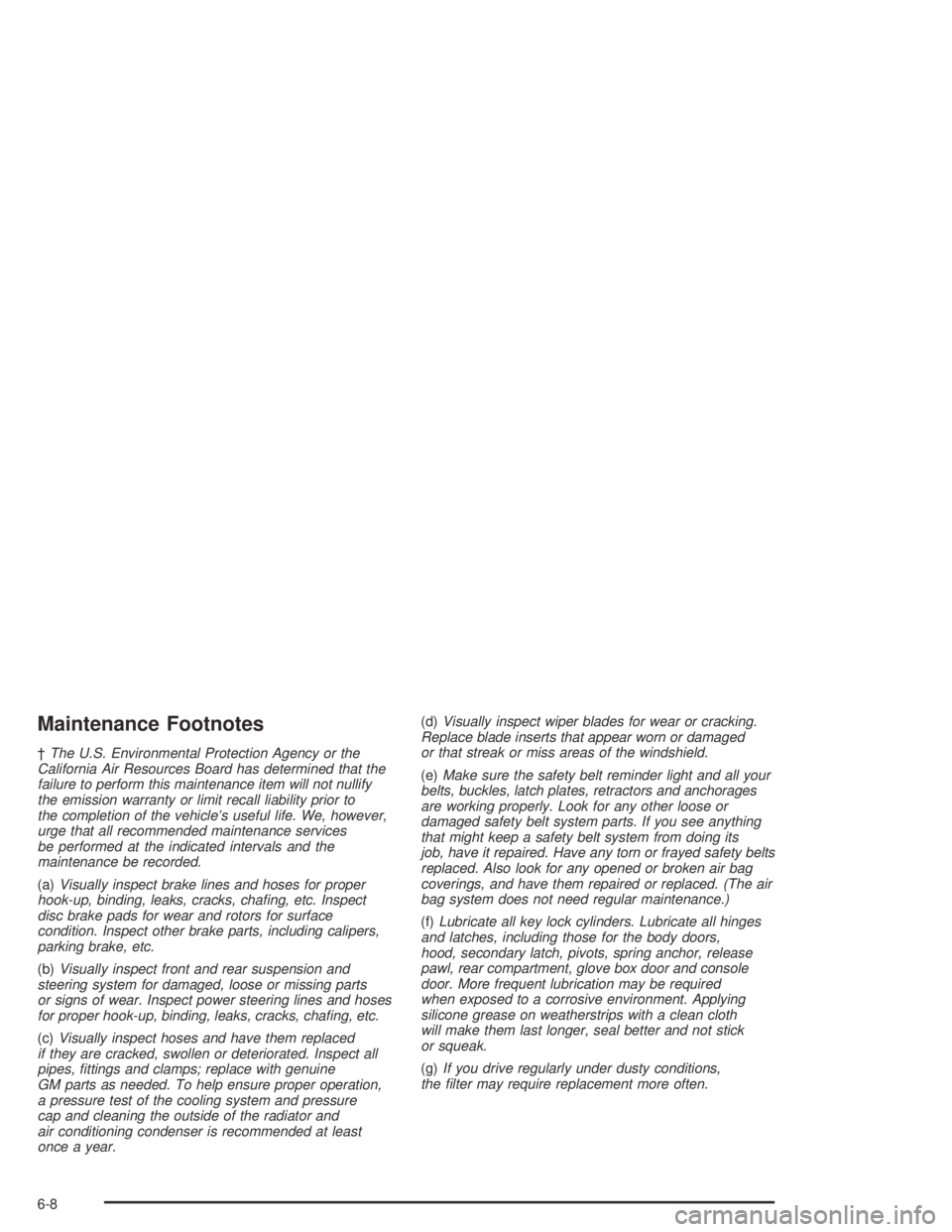2005 BUICK CENTURY radiator
[x] Cancel search: radiatorPage 239 of 348

How to Add Coolant to the Coolant
Recovery Tank
If a problem has not been found yet, but the coolant
level is not at the COLD mark, add a 50/50 mixture of
clean, drinkable water and DEX-COOL
®engine
coolant at the coolant recovery tank. SeeEngine
Coolant on page 5-22for more information.
{CAUTION:
Adding only plain water to your cooling
system can be dangerous. Plain water, or
some other liquid such as alcohol, can boil
before the proper coolant mixture will. Your
vehicle’s coolant warning system is set for the
proper coolant mixture. With plain water or the
wrong mixture, your engine could get too hot
but you would not get the overheat warning.
Your engine could catch �re and you or others
could be burned. Use a 50/50 mixture of clean,
drinkable water and DEX-COOL
®coolant.Notice:In cold weather, water can freeze and crack
the engine, radiator, heater core and other parts.
Use the recommended coolant and the proper
coolant mixture.
{CAUTION:
You can be burned if you spill coolant on hot
engine parts. Coolant contains ethylene glycol
and it will burn if the engine parts are hot
enough. Do not spill coolant on a hot engine.
When the coolant in the coolant recovery tank is at the
COLD mark, start the vehicle.
5-29
Page 240 of 348

If the overheated engine warnings continue, there is
one more thing that can be done. Add the proper coolant
mixture directly to the radiator, but be sure the cooling
system is cool before this is done.
{CAUTION:
Steam and scalding liquids from a hot cooling
system can blow out and burn you badly.
They are under pressure, and if you turn the
radiator pressure cap — even a little — they
can come out at high speed. Never turn the
cap when the cooling system, including the
radiator pressure cap, is hot. Wait for the
cooling system and radiator pressure cap to
cool if you ever have to turn the pressure cap.
How to Add Coolant to the Radiator
Notice:Your engine has a speci�c radiator �ll
procedure. Failure to follow this procedure
could cause your engine to overheat and be
severely damaged.
Remove the radiator pressure cap when the cooling
system, including the radiator pressure cap and upper
radiator hose, is no longer hot.
1. Turn the pressure cap slowly counterclockwise to
its �rst stop. Do not press down while turning the
pressure cap.
If a hiss is heard, wait for it to stop. A hiss means
there is still some pressure left.
5-30
Page 242 of 348

4. Fill the radiator with the
proper DEX-COOL®
coolant mixture,
up to the base of the
�ller neck. SeeEngine
Coolant on page 5-22
for more information
about the proper
coolant mixture.
If a stream of coolant is coming from an air bleed
valve, close the valve. Otherwise, close the
valves after the radiator is �lled.
5. Rinse or wipe any spilled coolant from the engine
and the compartment.6. Then �ll the coolant recovery tank to the COLD
mark on the coolant recovery tank.
7. Put the cap back on the coolant recovery tank,
but leave the radiator pressure cap off.
5-32
Page 243 of 348

8. Start the engine and let it run until you can feel the
upper radiator hose getting hot. Watch out for the
engine cooling fans.9. By this time, the coolant level inside the radiator
�ller neck may be lower. If the level is lower, add
more of the proper DEX-COOL
®coolant mixture
through the �ller neck until the level reaches
the base of the �ller neck.
10. Then replace the pressure cap. At any time during
this procedure if coolant begins to �ow out of the
�ller neck, reinstall the pressure cap. Be sure
the arrow on the pressure cap lines up properly.
11. Check the coolant in the recovery tank. The level in
the coolant recovery tank should be at the HOT
mark when the engine is hot or at the COLD mark
when the engine is cold.
5-33
Page 314 of 348

Maintenance Footnotes
†The U.S. Environmental Protection Agency or the
California Air Resources Board has determined that the
failure to perform this maintenance item will not nullify
the emission warranty or limit recall liability prior to
the completion of the vehicle’s useful life. We, however,
urge that all recommended maintenance services
be performed at the indicated intervals and the
maintenance be recorded.
(a)Visually inspect brake lines and hoses for proper
hook-up, binding, leaks, cracks, cha�ng, etc. Inspect
disc brake pads for wear and rotors for surface
condition. Inspect other brake parts, including calipers,
parking brake, etc.
(b)Visually inspect front and rear suspension and
steering system for damaged, loose or missing parts
or signs of wear. Inspect power steering lines and hoses
for proper hook-up, binding, leaks, cracks, cha�ng, etc.
(c)Visually inspect hoses and have them replaced
if they are cracked, swollen or deteriorated. Inspect all
pipes, �ttings and clamps; replace with genuine
GM parts as needed. To help ensure proper operation,
a pressure test of the cooling system and pressure
cap and cleaning the outside of the radiator and
air conditioning condenser is recommended at least
once a year.(d)Visually inspect wiper blades for wear or cracking.
Replace blade inserts that appear worn or damaged
or that streak or miss areas of the windshield.
(e)Make sure the safety belt reminder light and all your
belts, buckles, latch plates, retractors and anchorages
are working properly. Look for any other loose or
damaged safety belt system parts. If you see anything
that might keep a safety belt system from doing its
job, have it repaired. Have any torn or frayed safety belts
replaced. Also look for any opened or broken air bag
coverings, and have them repaired or replaced. (The air
bag system does not need regular maintenance.)
(f)Lubricate all key lock cylinders. Lubricate all hinges
and latches, including those for the body doors,
hood, secondary latch, pivots, spring anchor, release
pawl, rear compartment, glove box door and console
door. More frequent lubrication may be required
when exposed to a corrosive environment. Applying
silicone grease on weatherstrips with a clean cloth
will make them last longer, seal better and not stick
or squeak.
(g)If you drive regularly under dusty conditions,
the �lter may require replacement more often.
6-8
Page 315 of 348

(h)Change automatic transaxle �uid and �lter if
the vehicle is mainly driven under one or more of
these conditions:
�In heavy city traffic where the outside temperature
regularly reaches 90°F (32°C) or higher.
�In hilly or mountainous terrain.
�When doing frequent trailer towing.
�Uses such as found in taxi, police or
delivery service.
(i)Drain, �ush and re�ll cooling system. See Engine
Coolant on page 5-22for what to use. Inspect hoses.
Clean radiator, condenser, pressure cap and �ller neck.
Pressure test the cooling system and pressure cap.
(j)Check throttle system for interference or binding
and for damaged or missing parts. Replace parts
as needed. Replace any components that have high
effort or excessive wear. Do not lubricate accelerator or
cruise control cables.
(k)A �uid loss in any vehicle system could indicate a
problem. Have the system inspected and repaired
and the �uid level checked. Add �uid if needed.Owner Checks and Services
These owner checks and services should be performed
at the intervals speci�ed to help ensure the safety,
dependability and emission control performance of your
vehicle. Your GM Goodwrench dealer can assist you
with these checks and services.
Be sure any necessary repairs are completed at once.
Whenever any �uids or lubricants are added to your
vehicle, make sure they are the proper ones, as shown
inRecommended Fluids and Lubricants on page 6-13.
At Each Fuel Fill
It is important to perform these underhood checks at
each fuel �ll.
Engine Oil Level Check
Check the engine oil level and add the proper oil
if necessary. SeeEngine Oil on page 5-13for
further details.
Notice:It is important to check your oil regularly
and keep it at the proper level. Failure to keep your
engine oil at the proper level can cause damage
to your engine not covered by your warranty.
6-9
Page 345 of 348

Q
Questions and Answers About Safety Belts.........1-11
R
Radiator Pressure Cap....................................5-24
Radios..........................................................3-44
Care of Your Cassette Tape Player................3-65
Care of Your CD Player...............................3-66
Care of Your CDs........................................3-66
Radio with Cassette and CD.........................3-53
Radio with CD............................................3-45
Setting the Time..........................................3-44
Theft-Deterrent............................................3-63
Understanding Reception..............................3-64
Reading Lamps..............................................3-17
Rear Safety Belt Comfort Guides......................1-24
Rear Seat Passengers, Safety Belts..................1-21
Rearview Mirror with OnStar
®...........................2-29
Rearview Mirrors.............................................2-29
Reclining Seatbacks.......................................... 1-4
Recommended Fluids and Lubricants.................6-13
Recreational Vehicle Towing.............................4-36
Remote Keyless Entry System............................ 2-4
Remote Keyless Entry System, Operation............ 2-5
Removing the Flat Tire and Installing the
Spare Tire..................................................5-73
Removing the Spare Tire and Tools...................5-71Replacement Bulbs.........................................5-51
Reporting Safety Defects
Canadian Government..................................7-11
General Motors...........................................7-11
United States Government............................7-10
Restraint System Check
Checking Your Restraint Systems...................1-58
Replacing Restraint System Parts
After a Crash..........................................1-59
Restraint Systems
Checking....................................................1-58
Replacing Parts...........................................1-59
Retained Accessory Power (RAP)......................2-19
Right Front Passenger Position, Safety Belts.........1-19
Roadside
Assistance Program....................................... 7-6
Rocking Your Vehicle to Get it Out....................4-31
Routing, Engine Drive Belt...............................6-15
Running Your Engine While You Are Parked..........2-28
S
Safety Belt
Reminder Light............................................3-30
Safety Belts
Care of......................................................5-85
Center Passenger Position............................1-20
Driver Position............................................1-12
How to Wear Safety Belts Properly................1-12
9